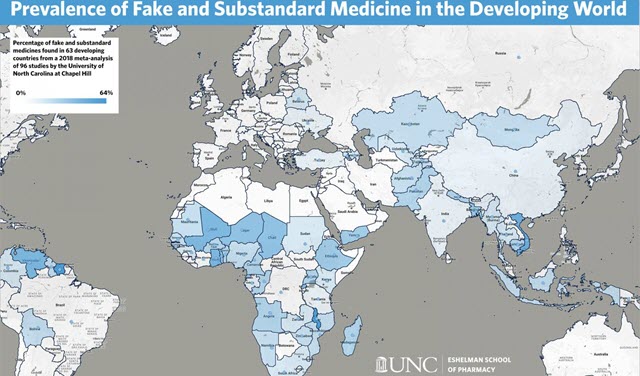 The color-coded map shows the percentage of fake and substandard medicines found in 63 developing countriesCREDIT: UNC Eshelman School of Pharmacy
The color-coded map shows the percentage of fake and substandard medicines found in 63 developing countriesCREDIT: UNC Eshelman School of Pharmacy
A new study from the University of North Carolina at Chapel Hill found that substandard and falsified medicines, including medicines to treat malaria, are a serious problem in much of the world. In low- and middle-income countries, more than 13 percent of the essential medicines that satisfy the priority health care needs of the population fall in this category. When looking specifically at African countries, the portion of substandard and falsified medicines rises to almost 19 percent.
Falsified medicines are medical products that deliberately and fraudulently misrepresent their identity, composition, or source. Substandard medicines are real medical products that fail to meet quality standards or specifications for a variety of reasons, including poor manufacturing, shipping or storage conditions, or because the drug is sold beyond its expiration date.
Researchers analyzed 96 previous studies of falsified and substandard medicines and each of the studies tested more than 50 medications. The team found that antimalarials and antibiotics were the medicines most commonly sold in substandard or falsified conditions. In low- and middle-income countries, 19 percent of antimalarials and 12 percent of antibiotics are substandard or falsified.
Sachiko Ozawa, an associate professor at the UNC Eshelman School of Pharmacy, led the research along with collaborators. The paper published in the journal JAMA Network Open on August 10.
"The prevalence of substandard and falsified medicines is a substantial public health problem because these medicines can be ineffective or harmful and can prolong illnesses, cause poisoning or lead to dangerous drug interactions," said Ozawa. "Our study shows that a concerted global effort is needed to improve supply chain management for medicines and to identify solutions to this understudied issue."
The researchers searched five databases for studies related to substandard and falsified medicines. They reviewed 256 studies and included 96 studies in their analysis.
"We need more global collaboration to implement laws on drug quality, increase quality control capacity, and improve surveillance and data sharing," said James Herrington, a professor in the UNC Gillings School of Global Public Health and a co-author of the study. "This can strengthen the global supply chain against poor quality medicines, improve health outcomes by reducing antimicrobial and anti-parasitic resistance and, ultimately, help governments, businesses and patients save money."
The team's analysis found limited information on the economic impact of poor quality medicines, with the estimates of market size ranging widely from $10 billion to $200 billion. Substandard and falsified medicines can burden health systems by diverting resources to ineffective or harmful therapies and cause additional treatment costs and reduced worker productivity due to treatable illnesses, but these effects have not been measured.










